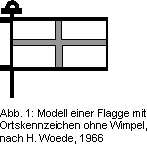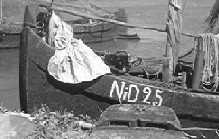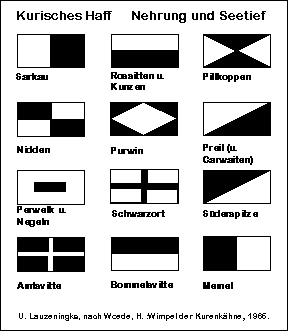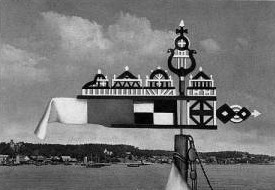The pennants of the
Courland Barges
The colourful wooden pennants on the masts of the barges on the lagoon have been one of the most popular subjects for artists and photographers. But in that form the signs existed not till the beginning of the 20th century. All of this started with the decree of a new set of rules for the fishing industry in 1844. The Prussian Royal Government has been discontented for a while with the way the fishermen were ignoring the current rules for the lagoon. For the authorities it was predatory fishing, theft. The fishermen claimed it as their tradition right as free fishermen to do what they want.
The new rules were set to protect and preserve the fishing grounds and
required close seasons for several fish species, the omission to fish with
fine-meshed nets and to throw spawn accidentally caught in the nets back
into the lagoon. Not only was spawn fed to pigs and fowl, sometimes they
sold it on the market in Memel (Klaipeda).  The
only fishing master in charge for the whole lagoon in 1834 apparently couldn't
cope with that situation.
The
only fishing master in charge for the whole lagoon in 1834 apparently couldn't
cope with that situation.
To change that, first the responsibility for the lagoon was given to one public authority located Königsberg. Until that point three spheres of competence with three different headquarters tried to call the fishermen to order. In 1844 the new set of rules were published and direct the entitled fishermen to have a flag for every barge signalling the village they belong to. The fine for not executing that order were 10 talers, for showing a sign of a different village the fine amount even to 15 talers.
A list of the designated colours were collected in a flag book and transferred to the village heads. In six week every fisher barge had to show a flag. The arrangement of colour and contrast should be ensure that the flags were clearly discernible from a distance and in the twilight. Because the fishing master was depending on the power of wind and sailing boats as well as the fishermen they tried to pursuit, they just weren't fast enough to catch them. So the new flags should help to identify any fleeing villain.
 The
combination of the geometric signs were random and not carrying any deeper
meaning. That's why different places around the spit wore the same flag
pattern, just in different colours. A dark cross against a light background,
for example, belonged in black and white to Schwarzort on the split, in
red and white to Gilge on the south-eastern coast of the lagoon, to Neufitte
at the Samland coast in blue and yellow and in blue and red to Laxdehnen
at the Vistula Lagoon (Frisches Haff).
The
combination of the geometric signs were random and not carrying any deeper
meaning. That's why different places around the spit wore the same flag
pattern, just in different colours. A dark cross against a light background,
for example, belonged in black and white to Schwarzort on the split, in
red and white to Gilge on the south-eastern coast of the lagoon, to Neufitte
at the Samland coast in blue and yellow and in blue and red to Laxdehnen
at the Vistula Lagoon (Frisches Haff).
The fishing decree of 1917 required still the showing of village flags, but in everyday life the marks on the boat flanks and on the sails became more and more important. Since the beginning of the century the flags were decorated with carved wooden ornaments which contained often a lot of symbols like houses and elks. It's sometimes said, that the pennants were telling the story of the family, but I couldn't confirm this with any former inhabitant of the spit.
The showing of the village flags changed over the years from something done under pressure of the authorities to a folkloristic custom.

